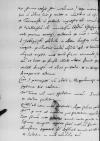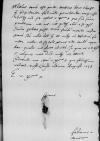Letter #1911
Fabian WOJANOWSKI (DAMERAU) to Ioannes DANTISCUSCracow (Kraków), 1538-08-31
| received [1538]-09-14 Manuscript sources:
| ||||
Text & apparatus & commentary Plain text Text & commentary Text & apparatus
Reverendissimo in Christo Patri et Domino, domino
Reverendissime in Christo Pater et Domine, domine gratiose
Salutis precatione servitiorumque meorum commendatione praemiss(a) or praemiss(is)⌈praemiss(a)praemiss(a) or praemiss(is)⌉ .
Venit huc
Interim his censui Vestrae Reverendissimae Dominationi significandum de singulis. Facit hoc idem dominus Eychler de equis, ut ei commissum est, et infra 10 dies scribemus plura per quendam Gregorium Pwff de Munsterberg, qui se consanguineum et servum Vestrae Reverendissimae Dominationis esse dicit.
Cum domino
Nova haec sunt et creduntur:
27 huius rediit huc incolumis serenissimus
Cras serenissimi
De
Quantum ad rem meam pertinet, ago summas gratias Vestrae Dominationi hidden by binding⌈[Dominationi]Dominationi hidden by binding⌉ Reverendissimae, quod me ad meliora pie hortatur auxiliumque offert hidden by binding⌈[ert]ert hidden by binding⌉. Ego semina mea praeteritis annis iacta puto in fertilissimos campos. Exspecto fatum meum cum fructu, sed rusticus exspectat, dum defluat amnis. At ille labitur hidden by binding⌈[ur]ur hidden by binding⌉ et labetur in omne volubilis aevum.  BCz, 1599, p. 93 Melius tamen esse puto tardius bene elegisse, quam praecipitanter festinando poenitenda arripuisse. Utcumque autem sit, credat Vestra Reverendissima Dominatio pro sua summa prudentia nec me, nec quemquam alium a se ipso similia habere posse.
BCz, 1599, p. 93 Melius tamen esse puto tardius bene elegisse, quam praecipitanter festinando poenitenda arripuisse. Utcumque autem sit, credat Vestra Reverendissima Dominatio pro sua summa prudentia nec me, nec quemquam alium a se ipso similia habere posse.
Dominus secundum merita nostra gratiam suam nobis dat. Quam et mihi non defuturam firmiter credo, ut scilicet tale genus vitae tandem ingrediar, quale me ducet ad vitam. In qua re Vestra Dominatio Reverendisisma cum reliquis meis dominis mihi non deerit.
Commendo me iterum Vestrae Reverendissimae Dominationi.
Quae felicissime valeat.
Dat(ae)
Eiusdem Vestrae Reverendissimae Dominationis servus



